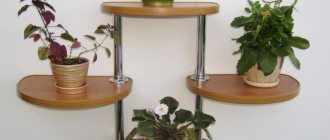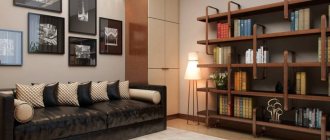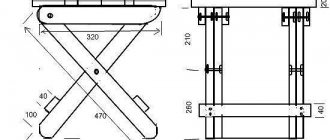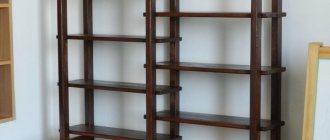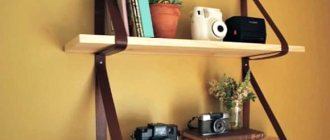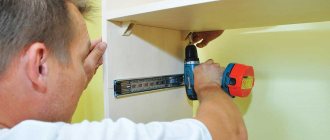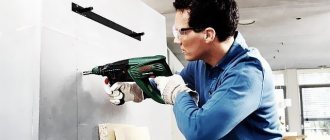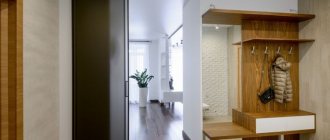So that the “goods” in the garage do not interfere with movement, it is necessary to somehow organize its storage. Garage racks are the most convenient. If there is enough space, they can be made on the entire wall or even on several walls. If there is no space below, you will have to move upstairs and make shelves under the ceiling. Not the best option, but sometimes the only one. Still, garage shelving that sits on the floor is safer, especially if it is securely attached to the wall (to avoid unpleasant situations).
Layout, diagrams, drawings, ideas
In the garage you need not only a rack, but also a workbench and a stand for hand tools - all kinds of keys and other small things, of which there are a lot and it is difficult to come up with a specific convenient storage place.
The workbench can be made in the center of the rack. This is convenient - everything you need will be at hand, you won’t have to constantly go to the shelves.
Garage shelving with workbench is convenient
The workbench can be part of the system, or you can make two separate modules, between which you can install the required table. If you don’t like this arrangement, you can change the configuration - at least put it at an angle.
As for the tool stand. There is a factory option - a perforated sheet of metal with holders hung on it. The idea is very good except for the price.
Comfortable))
As usual, there are also several homemade projects (what would a garage be without them) on the same topic. The ideas are simple to implement, maybe not so elegant, but convenient:
- On boards, chipboard sheets, plywood, place nails under each tool. To avoid confusion about where to hang something, trace the instrument in place and paint it with some color.
Everything is in order and in its place
- For heavier equipment - large keys, etc. You can use a mesh onto which you weld hooks from wire. Nail the mesh to the wall.
Option for heavier and bulkier tools
- Make a bar with holes cut in it into which tools are lowered.
This tool stand is very easy to make with your own hands.
And if desired, all this can be put on wheels - to make the tool stand mobile. This is the case if during the warm season you prefer to work with the machine outside.
You can easily roll back to where you want
Well, for inspiration... so that all the tools are in place))
Full order))
Main technical characteristics of shelves for racks
The main components of any rack are: racks, crossbars, shelves, and, if necessary, transverse ties. Tightenings allow you to strengthen the product and are two metal strips that are welded or screwed to the racks.
For the most convenient use of a metal garage rack, during design and installation you must adhere to a number of rules:
- shelves for any type of structure must withstand a certain load and not be deformed;
- the design should be as functional and compact as possible;
- The overall dimensions of the shelves can vary: width - 1.5 - 2 meters, height - 20 - 100 centimeters, depth - 20 - 20 centimeters.
In addition to choosing the main design, you can also play with the type of shelves themselves, the main ones being:
- open. Can be vertical (for wheels), horizontal. When installing such shelves, all your things will be in the public domain;
- closed. Help prevent the loss of things;
- removable. They make it possible to vary the overall dimensions (length and height) of the structure;
- separated. A distinctive feature of a storage system with such shelves is that the shelves are conventionally divided into cells, allowing you to organize and systematize things.
Read also: Alcohol in a blowtorch
Wooden shelves with metal frame
Rack with metal frame
An alternative design option, which is a more expensive, but at the same time more durable and durable solution. The racks in these shelves are made of metal, and the surface of the shelves itself is made of wood or any materials of wood origin.
Such a rack has a higher resistance to moisture and mold. It is more resistant to heat and fire. Moreover, by using metal parts, they can be made dismountable, which will allow you to change the appearance of the structure according to any desire of the garage owner.
Materials and tools needed for work
Corners for shelving in the garage
The racks of such a rack are made from rectangular pipes or from a profile with a width of one of the sides of 5 cm. A 30 mm corner is best suited as crossbars.
The frame is made from a corner, and the thickness of the shelf should be from 1.5 to 3 cm (along the height of the corner). Crossbars made from angles can be attached to the guides in different ways - by welding or using bolts. It all depends on the wishes of the owner.
If you need a durable structure, then welding is preferable; if you require the versatility of the product with the possibility of its further modernization, you should use bolts. The use of bolts allows, for example, to change the height of each level.
Shelves can traditionally be made from any material on hand - from pine to OSB. For reasons of strength, their thickness should not be less than 12-15 mm.
For work you will need the following set of tools:
- drill (screwdriver)
- Bulgarian
- wood hacksaw
- corner
- level
- welding machine (optional)
Manufacturing procedure
Shelf frame from a corner
It is best to assemble the rack in a free room, and it is advisable to empty the garage of unnecessary things and remove the car from it.
After assembling the frame, it should be screwed to the wall. The assembly sequence is as follows:
Based on the finished measurements, the material of the racks and corners for the shelves is cut using a grinder. The racks are marked in those places where shelves will be attached to them. The corners are screwed to the racks using bolts (or welded in the case of a stationary structure)
In this case, it is extremely important to maintain a connection angle of 90°, otherwise the structure will turn out skewed. Similarly, the racks are connected to each other using crossbars, but at the same time, right angles must be maintained not only between the racks and crossbars, but between the crossbars and the previously attached corners. The assembled structure is installed on its place and screwed to the walls and floor. This can be done, for example, using anchor bolts. The metal frame is sanded using a grinder with an appropriate brush attachment and coated with a primer or paint containing a primer
At this stage, in order to facilitate the labor-intensive process of mechanically cleaning the frame from rust, you can use a chemical rust converter. Typically, converters require a day to dissolve the rust; after which it is possible to paint the surfaces without any mechanical or chemical treatment. After the paint has dried, shelves are cut out of wood or wooden materials and adjusted in size to the finished frame structure. The shelves are sanded, painted or varnished, and then attached to the frame using bolts or self-tapping screws
VIDEO: DIY universal shelves
Shelves in the garage: order comes first. General design issues, simple options, step-by-step instructions for making your own (75+ Photos & Videos) + Reviews
Deciding on the design
Scheme of a simple garage shelving
Making your own garage shelving is quite easy. The most important thing is to clearly define your own desires and needs, plan the design and type of construction in advance. Anyone can do such tasks, especially if they have a great desire to do something with their own hands.
Drawing of a rack made of pipes with wooden shelves
The design of the racks has three elements: vertical posts, shelves, crossbars. In some cases, transverse tightening is used. They are not required. They are needed only to increase the rigidity of the frame. To determine the exact design option for the future rack, follow these recommendations.
- The depth and height of the shelves are arbitrary. These parameters are selected only based on the purpose of the niche. Each shelf can be designed to store a specific type of item. It is better to decide all this in advance;
- The distance between the vertical posts must be selected based on the rigidity of the material. For very heavy accessories, the distance should be about 1.5 meters. For long racks, you need to prepare intermediate vertical racks. They will make the system more resilient;
- The lower shelves should be at some distance from the floor. Approximately 50-70 cm. Heavy objects should be stored on them. The optimal height of the remaining shelves will be 37 cm. This is the most rational height, often used in the manufacture of any furniture structure.
Drawing of a metal rack for a garage
It is always easy to decide on design features. Garage owners simply take into account the dimensions and features of the things that will be stored in the structure.
Option for a small garage with a workbench
It is a little more difficult to choose a product design. The garage is intended for practical purposes. However, this does not mean that its interior should be boring and ugly. You can easily create an attractive interior in your garage for little money. In particular, you can decorate the shelving design with regular paint. Today there are paints designed for any material. The color for painting should match the overall color scheme of the room. Colored plastic boxes for storing accessories and tools will become a kind of decoration. They are inexpensive and allow you to create perfect order.
Transparent and multi-colored plastic boxes for garage shelves
Principles and possibilities of arranging a car garage
The main purpose of a garage is to store a car. This means that first of all, the car owner must eliminate possible attacks on the property stored inside, that is, ensure the safety of the latter. An equally important issue is the correct climate regime in the garage space - the condition of the car should in no case depend on the vagaries of the weather or the appetites of harmful microorganisms such as fungus or mold. Another principle of organizing the situation in the garage - ergonomics - says that everything under the roof of the structure should always stand, lie or hang in its place, without interfering with the passage, travel, cleaning or car care process. With all this, it is imperative that the premises be clean and orderly, which are the key not only to the health of the car owner, but also to his safety when visiting the garage and performing all kinds of business or repair operations.
In accordance with these principles, at the first stage of arranging a garage you will need:
- Install a reliable locking system on gates and windows, if any.
- Insulate the structure of the structure or organize high-quality heating of the interior during the cold season.
- Carry out interior decoration with reliable, durable and easy to clean materials.
After completing the finishing work, you can begin the final stage of arrangement - organizing the interior of the garage. To do this, you need to draw up a detailed plan of the premises and determine what and how exactly will be stored in it, in addition to the car.
Garage plan for a car with estimated dimensions
As a rule, the wall farthest from the entrance to the garage is allocated for racks and shelves. If the dimensions of the room allow, it is advantageous to equip the side walls with shelves
If there is a lack of free space in the garage, special attention should be paid to the space under the ceiling, as well as above the car itself. Shelves equipped on the upper level will allow you to relieve the lower part of the room by storing things that need to be used from time to time.
Wooden shelves on a metal frame under the garage ceiling
The configuration and dimensions of the racking system depend on the size of the garage and the needs of its owner. The materials from which the shelves will be made must be strong enough to support the weight of the items being stored. For example, tiers can be made of thick plywood or boards, and the frame can be made of metal pipes or corners, but other options are also possible.
Wooden shelving system for a garage
The method of assembling and installing the rack system depends on the material used to decorate the garage, as well as the design features of the structure itself. In many cases, shelves are hung on the walls, and racks are installed directly on the floor. However, shelves can also be hung from the ceiling, while to increase the stability of a separate rack, its frame is often equipped with fastenings for walls, floors and ceilings.
Open Hanging Garage Shelving System
Metal or wood?
When deciding on the material from which you plan to order or make a rack yourself, you should pay attention to the positive, negative characteristics and the feasibility of using a product made from a particular material.
First of all, there are several important factors to consider:
- what type of rack will be used, where they will be located;
- total load on the product (what exactly will be stored: dimensions, weight, quantity);
- temperature indicators, percentage of humidity and other characteristics of the room.
Why is it so important to consider all of the above? Take wooden shelves for example. Despite the fact that a well-dried board is practically not affected by temperature changes, it is very sensitive to high humidity, which can lead to many negative processes: fungus, deformation, mold. To neutralize such consequences, the future wooden product should be treated with special antiseptics (substances that kill biological pests). Do not forget also that wood is highly susceptible to the influence of chemicals and has a high degree of combustion.
Unlike a wooden one, a metal garage rack:
- resistant to chemical substances;
- with low weight it can withstand heavy loads. The weight that one shelf can support is 120 kg, and with appropriate reinforcement, up to 300 kg;
- it is not afraid of even sharp fluctuations in temperature and changes in humidity (provided it is painted with a polymer dye);
- does not require special knowledge and is quickly assembled even by a non-professional.
What materials are garage shelving made from?
The service life of the structure depends on this condition. Wood and metal are commonly used. Let's look at what material you can use to make tool shelves in your garage with your own hands.
The material used to make the shelving depends on where and how you are going to place it.
- Metal. It is durable, strong and can withstand any load. But with excessive humidity, it quickly begins to deteriorate without preliminary anti-corrosion treatment. It is very easy to care for such a structure; you just need to wipe off dust and treat it with stainless steel;
- Wood. It is better to make them hanging shelves. Not suitable for heavy structures. It is best to opt for oak, pine or birch. It is better to secure the boards using iron corners. In a dark and damp room this is not the best option, since after some time the wood begins to rot;
- Plastic. Perfect for storing light weight items. For example, in the form of containers or boxes. Plastic is lightweight, which allows the structure to move freely. But this material has a significant drawback - its fragility. With little physical impact it breaks easily;
- Combination of several materials. Usually it is metal and wood. This is the best option, since together you can get the highest quality and durable design.
If you are planning to build a large rack to store heavy items (such as tires), then it would be optimal to use a steel structure.
In addition, you can use improvised items: plastic containers, flower pots, and so on.
If necessary, you can buy ready-made shelves or make them yourself.
If you properly process the wood, these shelves will last in the garage for quite a long time, and you won’t have to complain about them.
Which shelves and shelving structures are suitable for the garage ↑
The easiest way to equip your garage with ready-made systems is to choose a stylish option with a simple fastening mechanism. But it’s not always possible to guess with the dimensions of the shelves, and besides, not all purchased options will be as functional and reliable as we would like. It’s more convenient, more profitable and more logical to make a shelf or rack yourself. As a result you will get:
- saving space;
- eliminating clutter;
- convenient storage of tools and other things;
- giving the garage (hangar) a well-groomed, lived-in appearance.
Types of shelving designs
The type of design depends on the availability of free space, the purpose of the rack, the material it is made of and the intended method of storage system. Designs can vary both in the method of assembly and in the type of racks.
Stationary shelving system
It is installed in a specific location on a permanent basis. Such designs are designed for heavy objects - they can withstand heavy loads.
Before installation, it is very important to carefully consider the location of the rack and draw diagrams that take into account all the dimensions and area of the garage itself. Such systems are assembled once, usually using brackets
Mobile mobile racks
Such a system, if necessary, can be moved or transferred to any place without unloading. This is very convenient if you need the tool outdoors. The rack is equipped with special rubberized wheels with a diameter of 10 cm. If desired, they can be fixed, limiting the possibility of movement.
Collapsible models
The shelves of these racks can be mounted to any height using nut or bolt fastening. Among car owners, such designs are considered the most acceptable option. They can be easily disassembled and adjusted at will, changing the height, and also rearranged to any place in the garage.
Hanging or wall shelves
They are attached to the surface of the ceiling or wall anywhere. They allow you to save space and make the most efficient use of free space. A similar structure can be assembled from a corner and hung on special hooks.
Rotating models
This interesting option can be installed in a room where you want to emphasize a certain style. These racks can rotate, providing access to tools and materials from any side. This setup visually resembles a rack of CDs or postcards.
Closed
Such designs protect against the loss of small items and tools and create the appearance of order. They can accommodate both valuable tools and various unsafe materials. In addition, such structures protect stored items from excessive dust.
Closed shelving is made of plastic, metal or wood. Inside they can be divided into cells.
Open
They allow you to quickly access any parts and objects - everything is in plain sight and there is no need to open and close the doors. The structures can be wall-mounted or suspended. To securely fix them, you need to install anchors in advance.
Separate tool cabinets
They can be made in the form of open cells, hooks, magnets or installations with holes. Heavy spare parts and tools cannot be placed on such panels. But they are ideal for storing small items that you need to always have on hand.
Optimal dimensions and distance to the car
The dimensions of the storage structure depend on the number of things intended for storage and the size of the garage itself. Small garages often have just a few hanging shelves for storage. In large and spacious garages, it is advisable to make a large shelving unit occupying one of the walls.
Below we present the most optimal dimensions of a garage rack:
- Width. The most common and convenient shelf width: 1 meter.
- Height. Recommended height of each shelf: 30-50 centimeters.
- Depth. 50-60 centimeters will be quite enough to accommodate objects of different sizes.
Types and purpose
Professionals recommend carefully considering all the details for making shelves and racks with your own hands, this also applies to the type of construction.
Most products are needed to store tools or parts of various sizes.
At the same time, there are several types of classification, the first of which talks about the design features:
Open. Necessary for quick access to a certain thing. The open type of shelves is divided into wall-mounted and hanging. Wooden or metal bases are hung on the wall using corners, the fastening of which can be dismantled or permanent. Special anchors must first be installed on the wall to hold the entire structure.
It is recommended to divide into cells for certain types of tools or small parts. For example, it is possible to sort different types of screws.
Common materials used are wood or metal. In rare cases, the structure can be made of plastic. However, based on practice, the ideal option would be to implement a combined type design.
The following assembly options are suitable for making your own:
Removable or mobile. The shelves form a rack with wheels on the lower tier. The mobile base will ensure optimal load distribution.
- Permanent. The shelving system is designed for specific areas that need to be pre-allocated. To do this, you should initially create drawings that involve dividing the garage into several parts. The standard option includes one-time assembly and fastening of the integral structure with brackets.
- Collapsible products. They are convenient because they can be expanded and easily dismantled in case of replacement or renovation of the premises. The height and number of shelves can be adjusted, and it is also possible to rearrange the shelves to a new location.
- Attic shelf. Hanging shelves are made of a corner and a metal profile, which serves as a base. The entire structure is usually attached to the ceiling or beams, thereby saving space in the garage compartment. For fastening, you will need to install special hooks; they need to be driven in or welded to the ceiling beams. This way they can be easily disconnected if necessary.
- Rotating products. These structures are not intended for storing large items. Their main advantage is saving time in searching for suitable parts. For example, self-tapping screws or nuts.
When choosing a product, you should start from the parameters of the room. It is also necessary to remember that the more, the better, the more spacious and convenient.
Requirements for racks and shelves
Important design characteristics are reliability and functionality. Special requirements apply to the dimensions of the shelves. They should be convenient for storing parts, tools, spare parts and give the garage a well-groomed and lived-in look.
To prevent a chaotic dump, it is advisable to properly organize the space inside the garage. This can be done using a homemade shelving unit. It will allow you to rationally and neatly place things and create comfortable conditions for car care and solving everyday household problems.
When choosing the type of rack you should consider:
- construction material - you should choose one that can be easily cleaned from dirt;
- strength - shelves should not bend easily under weight and be damaged by impacts and scratches;
- sustainability.
Assembly of metal and wooden structures
Planning to make a wooden or metal rack or shelves with your own hands is half the battle. You will need to realize your plans, build your dream, and translate it into wood or metal.
The assembly of homemade products is often not given due attention, being carried out in a hurry, so “home” designs, for all their advantages, look unattractive, worse than factory ones. Before installation, the iron frame is finally adjusted, sharp edges are sanded, and preparations are made for future painting. Suitable installation methods include welding, bolting - anything that will provide the required rigidity.
It is easier to work with wood - it is fastened with nails, self-tapping screws of the required length, and corners. It is better to drill holes, keeping in mind the tendency of the material to chip and split. For wood, a prerequisite is treatment with compounds that prevent rotting and fire. The chosen assembly method must guarantee:
- relative ease of implementation;
- reliability, structural rigidity.
Taking into account these nuances, building a rack is not as difficult as it seems at first. If, of course, you plan correctly and provide for as many little things as possible that may affect the progress of work in the future.
We do everything ourselves
To make your own storage system, you will need:
- rectangular pipes or metal profiles, no more than 5 centimeters wide;
- corners, take 30 mm;
- transverse metal puffs;
- metal shelves or chipboard;
- bolts, self-tapping screws:
- welding machine;
- screwdriver (drill);
- Bulgarian;
- level;
- hacksaw for metal.
- draw a drawing with the main dimensions. Think through all the nuances in advance, this will help save material and your time;
- we cut the profile into the blanks we need;
- on the racks we mark the places where the shelves are attached;
- we attach corners for shelves;
- we cover the entire structure with an anti-corrosion compound or paint;
- if chipboard shelves are used, then we fasten them with self-tapping screws. In wooden shelves, make several holes throughout the entire area, thus ensuring normal air circulation and preventing excess moisture from appearing on things stored in the garage.
Well, we hope that our article has helped you at least a little in understanding the choice of storage system for things in the garage. As you can see, the choice is quite large. Go for it!
Orderly placement of tools, spare parts, building materials and other items is provided by racks made of metal corners. Such metal structures are installed in garages, home and repair shops, utility rooms, and cellars. The simplest option is to purchase a kit to create a prefabricated shelving unit.
It contains: a corner (aluminum or galvanized steel), shelf covering treated with special antiseptic compounds (for wood materials), fasteners. The shelves can be installed at different heights. Such kits are convenient and functional, but, as a rule, they are not intended for heavy loads. In addition, these metal structures have low rigidity due to play at the joints. Therefore, craftsmen with metalworking and welding skills prefer to make racks with a metal frame from a corner with their own hands. The advantages of this option: the ability to build a structure of optimal size and load capacity and financial savings.
Features of assembling metal shelving
Metal racks can be welded or assembled with bolts. There are usually no problems with welding. If a corner is used, the joints can be overlapped - a difference of 3-5 mm when laying shelves is unnoticeable. If you wish, you can cut out the excess in one of the shelves and butt weld, but trimming takes a lot of time, and you still won’t see much of a difference.
How to cut corners for a smooth connection
When assembling a frame for a bolted shelving, the order is as follows: first, assemble the squares of the sidewalls and shelves separately, then screw them together. It is advisable to have at least two bolts for each connection - for greater rigidity (less play).
If you assemble garage racks from a profile pipe with your own hands, the procedure is different. First, the sidewalls are assembled, and short crossbars are attached to them. You get two rectangles with crossbars. Then they are connected by crossbars.
Methods for bolting profile pipes
See the photo for how to make connections. In one case, welding is still needed - weld the heel pad, in another you can do without it - cut out the "ears", bend them and cling to them.
There is another way - special crab systems. These are metal plates with recesses molded to fit the profile. Pipes are placed into the grooves, then the two plates are bolted together.
Crab systems for profile pipes
Such a connection is unlikely to withstand very heavy loads, but there is an undeniable advantage - you don’t have to drill a bunch of holes in the metal. In a profiled pipe this is certainly easier than in a thick-walled corner, but it still takes a lot of time and effort.
By the way, the bolts used are M8 or M6, so large holes are required for them. It is easier to first drill with a thin drill, then expand to the desired size with a thick one. But even with this order, you will need a significant number of drills. To make them overheat less and break less often, place a jar of water nearby and periodically lower the drill into it.
Welded
Used to create large metal shelving. It has impeccable reliability and the ability to withstand even the most severe loads. Most often, shelves of this type are used to store large items.
There is one significant drawback - during redevelopment, it is often not possible to fit such a rack into the new space due to the non-demountable design. So if you love change, there is reason to think about choosing a different type.
Bolted
The main advantage of such a shelf is mobility. All parts are bolted together and can be easily dismantled if necessary. However, even with perfect assembly, there may be some play at the connection points. It is either present immediately or appears over time under the influence of the mass stored on the shelves.
The disadvantages of this design can be overcome by fixing it to the walls.
Combined
Typically found in spacious garages and technical rooms for car repairs. Most often it is formed through the so-called build-up - when there are more and more tools and storage items, but there is no other place for a new shelf and is not expected.
Sources
- https://www.yaprofi.net/polki-svoimi-rukami/
- https://stroychik.ru/garazh/polki-i-stellazhi-dlya-garazha
- https://www.asusfone.ru/svoimi-rukami/samodelnyj-stellazh-dlja-hranenija-v-sadovom-sarae-iz-staroj-mebeli
- https://postroika.biz/24568-stellazh-iz-dereva-svoimi-rukami.html
- https://garazhmechty.ru/polki-v-garazhe-svoimi-rukami.html
- https://1dacha-sad.com/delaem-stellazh-dlya-garazha-svoimi-rukami
We fasten with bolts or choose welding
So we’ve decided on the material, now let’s move on to choosing a method for assembling the metal components. One of the assembly options is a welding machine. Such structures are a non-demountable structure with high stability.
The second option is to assemble the rack using bolts. It is advisable to make such prefabricated options provided that over time they are planned to be moved to another place, or there is no opportunity (knowledge) to use welding. However, please note that such systems have less rigidity. To strengthen them, they are often fastened to the wall.
Drawings and options
Many shelving drawings are available on the Internet. But in order to choose the right one, you need to decide on the future use of the structure. For storing tools and spare parts in the garage, a rack measuring 500 x 2000 mm with four shelves of 450 mm each is suitable. But for a cellar with conservation, you can make more shelves - every 300 mm. Warehouse structures require an individual approach, taking into account the size of the stored boxes.
The most common shelving options are:
- design 500 x 1800 mm with four shelves;
- rack 600 x 2000 mm with three shelves;
- combined models measuring 500 x 1800 mm with a high shelf at the bottom of 700 mm and three shelves for small parts of 350 mm each.
If the items for which the rack is designed will constantly change in size, then there are universal designs where the distance between the shelves is adjusted. To do this, several holes are drilled in the main racks at the level of future shelves. Only the main frame (cube) is welded, and all internal elements are bolted. This way you can add or remove the number of shelves, as well as change the distance between them. This is especially convenient to do if the main racks are from a corner. Holes are drilled in them and the shelves, and for fixation two bolts are used on each side.
If you need a long rack, it is recommended not to make it on the entire wall, but to leave small gaps of 100 mm from the side walls to make it more convenient to install the metal structure in place. There are no strict size restrictions on the depth of the shelves, but it is worth considering the convenience of retrieving items. For example, if the depth is 1000 mm, then not everyone has enough arm length to reach the part under the wall. But if the structure stands in the middle of the workshop, and there is access from both sides, then you can make shelves 1500 mm deep.
The height of the racks is made individually. It all depends on the materials available and future use. But in any case, it is not necessary to make the height up to the ceiling, because the upper part can also serve as a shelf, on which only a small threshold (150 mm) is provided so that the objects located there have somewhere to rest, if they are located vertically.
There are combined models of shelving, where there is a high shelf for large items (engine, wheel) and small parts. The reinforcement under the shelves depends on the future weight of the load. If these are heavy car parts, then it is worth welding an additional jumper under the middle of the shelf. Based on this, the number of main racks is determined. Excessively large spans will lead to sagging and deformation. But if the design is made for small parts, then the outer racks are quite enough.
Design Tips
When planning storage shelves, you need to calculate everything and make sure that they will withstand the expected weight of the items, they will fit comfortably on them, and the design itself will not interfere with either the car or its owner.
It is best to make a preliminary drawing or just a sketch, transferring all the measurements onto paper and thinking through the methods of connection and fastening. When creating a project, we suggest taking into account the following recommendations:
- The thickness of the shelves depends on the material and the expected load. As a rule, for storing tools, wheels and other heavy objects, wooden shelves are made at least 30 mm thick;
- The distance between the supports is also of great importance. The greater the weight and the smaller the thickness of the flooring, the smaller this distance should be. The optimal shelf length in terms of reliability and convenience is considered to be from 80 to 120 cm for wooden structures and 150-200 cm for metal ones;
- their depth should not exceed 60 cm, otherwise it will be inconvenient to get something from the shelf. But this parameter is selected taking into account the purpose and depends on what exactly is supposed to be stored on this tier. If shelves from floor to ceiling of different depths are needed, then it should decrease from bottom to top;
- This rule also applies when choosing the distance between shelves: the highest should be the lowest. Large and heavy items are stored on them, while small and light items can be placed higher.
In general, first of all, you should proceed from your own needs, the number and type of items for storing which the system is created. At the same time, they try to make good use of every centimeter.
Wood shelf
Wood is more environmentally friendly and economical compared to metal
The most common solution for arranging a garage is the installation of wooden shelves. The choice of this option is due to the availability and low price of wood: bars and boards. In order for the structure to be aesthetically attractive and safe to use, all its elements are pre-treated: leveled, sanded, coated with a fire-retardant composition.
Design + drawing
Drawing of a wooden shelf
Designing a shelf made of wood is no different from a similar process in the manufacture of metal structures. The dimensions of the parts are chosen at your discretion. The most convenient are shelves whose length corresponds to the distance of an outstretched arm. The height can be any, up to the ceiling. The easiest way to design and manufacture a permanent wall structure. It is installed in a corner or on a plane.
Required tools and materials
Before starting work, the tree must be planed
To work with wood you will need:
- drill or screwdriver;
- drill;
- hacksaw or jigsaw;
- sander;
- bubble level;
- construction square;
- ruler and tape measure;
- simple pencil.
Materials for making a simple wall shelf 110 cm long, 30 cm high and 25 cm deep (width):
- planed boards 16 mm thick;
- wood screws;
- dowels for fastening to the wall;
- brackets
- fire-retardant composition.
Manufacturing instructions
Surface preparation in full swing
Step 1. Using a jigsaw or hacksaw, prepare two blades for the side walls. Between them there will be two horizontal shelves. The distance between them is equal to the height of the end ones.
Step 2. Prepare canvas for horizontal shelves.
Step 3. Process the parts with a grinder.
Step 4. Cover the workpieces with a fire-retardant composition and allow drying time recommended by the manufacturer.
Step 5. Start assembling the structure and lay the bottom sheet on a flat horizontal surface. Take a ruler and a simple pencil, measure 8 mm on the right and left, draw two parallel lines.
Step 6. On each line from above and below towards the middle of the canvas, measure 5 mm and put marks.
Step 7. Drill 4 holes at the found points.
Step 8. In a similar way, mark the surface of the top shelf and drill 4 holes in it.
Step 9. Install the left end shelf on the bottom shelf. Connect the parts with self-tapping screws.
Step 10. The right end board is attached in a similar way.
Step 11. Place the top shelf on the resulting structure and attach it through the previously drilled holes.
Step 12. Brackets are attached to the upper part of the back surface of the end boards.
Step 13. Try the shelf against the wall, make markings for the dowels.
Step 14. Drill holes in the wall.
Step 15. Screw in the dowels.
Step 16. Hang the shelf.
Based on the proposed step-by-step instructions, you can make a structure from several shelves, strengthening it with vertically installed bars with a section of 40x50 mm or 50x50 mm. In order to give the shelf stability, it is attached to the wall with anchors or dowels.
Hanging shelf with studs for garage
Hanging shelf with studs for garage
If you want to save useful space in the room, you can make a hanging shelf with your own hands and attach it to the ceiling.
Materials required for the manufacture of the structure
- Material for flooring the bottom of the shelf. You can use plywood, fiberboard sheets (the thickness of the material should be more than 2 cm).
- Large anchors (4 pcs.).
- Hex nuts - couplings for couplers (4 pcs.).
- Regular nuts (12 pcs.).
- Hairpins (4 pcs.).
- Large diameter flat washers (8 pcs.).
- Grover washers (4 pcs.).
Tools for work
- Drill with a drill bit for wood. The diameter of the drill must match the diameter of the stud.
- A hammer drill for drilling holes in the ceiling for mounting anchors. The drill should be slightly smaller than the diameter of the anchor.
- Wrenches, their markings must match the size of the nuts used.
- Jigsaw.
- Screwdriver.
- Bubble level.
Work order
Hanging shelves
Step 1. To begin, cut out a shelf of the required width and length from a sheet of plywood or fiberboard.
Hanging shelves
Step 2. To enhance the strength of the material, you can attach a metal profile equipped with internal stiffeners to the ends of the slab.
Shelf manufacturing process
Step 3. Holes for the pins are marked along the edges of the shelf. It is worth knowing that it is advisable to drill 5-7 cm from the edges of the slab. If the holes are located too close to the ends, the material may crumble under the weight of the items placed on the shelf.
Step 4. After the holes are drilled, you need to attach the shelf to the ceiling and use a pencil to transfer the location of the holes to the ceiling. This way the structure will be positioned without distortion and you won’t have to worry about the studs becoming deformed.
Holes for anchors are drilled in the ceiling and dust is removed from them. The anchors are driven into the concrete all the way and the nuts are tightened.
Anchor bolt
Driven anchor
Long metal studs connect to anchors placed on the ceiling. The connection is secured using coupling nuts. It is also advisable to secure the connection with an additional regular nut, which is screwed onto the thread of the stud.
Anchor attachment
Anchor fastening.png
Attaching an anchor to the ceiling
Step 5. After the studs are firmly fixed to the ceiling, the period of installing the shelf begins. A nut is screwed onto the stud, then a washer. After this, a shelf is strung on the ends of the studs.
The pin is secured
The shelf is fixed using a Grover washer and a control nut. The washers protect the shelf holes from breaking under loads. The bushing serves as protection against loosening of the fastening nut. You can use two nuts for safety and greater structural strength. The final adjustment of fastening fittings is carried out according to the level.
Hanging a shelf
Hanging a shelf
Fastening the ring nut under the shelf
This hanging shelf will significantly save space in the garage. The only drawback is the mobility of the structure. You can eliminate it using a special metal corner. One edge of the corner is attached to the wall, the second - to the base of the shelf. This way the entire suspended structure is fixed. Also, a metal corner will strengthen the shelf, which will affect its durability.
How to assemble a rack from an aluminum profile with your own hands
Assembling a rack with your own hands from a profile can be done even by a person taking up this task for the first time. It is easier to work with than wood.
The main advantage of the modular design is the ease of assembly from a ready-made kit
Materials and tools
To calculate how much material is needed, first sketch out a sketch indicating the dimensions and number of shelves. Profile dimensions are selected depending on the expected load. To connect the parts, you will need self-tapping screws with press washers, since their fastening is more reliable. It is better to take pointed ones, since drill ones make large holes, so the strength is reduced. Shelves are made from boards 2 - 3 cm thick, 10 mm or more plywood, OSB sheets no thinner than 12 mm.
To work you need to stock up on tools:
- Tape measure, pencil or felt-tip pen, square for checking angles.
- Metal scissors for cutting profiles.
- Screwdriver. If you screw in each screw manually with a screwdriver, it will take several days to assemble the frame.
- A wood hacksaw for cutting shelves. The process will speed up if you have a circular saw or jigsaw.
Build process
When the materials and tools are prepared, begin assembly:
- On the profile, mark the length of the racks, crossbars, and crossbars along the width of the shelves. To prevent the rack from turning out crooked due to errors with the dimensions of the workpieces, you need to re-check the correctness of the markings.
- On the side walls of the profile, cuts are made to the base and bent at this point. The workpiece is cut along the fold line.
- Longitudinal cuts are made on the crossbars to a depth equal to the width of the profile of the vertical supports. Internal bends, if any, are cut off.
- The crossbars are inserted into one another to form a rectangular cross-section. The cut ends are bent 90⁰. You need two of these parts for each shelf. They are installed on both sides of the frame.
- The assembly of the sidewalls, so that there are no distortions, is carried out on a flat surface, possibly on the floor. Cross members are inserted between a pair of vertical supports. After checking the corners, each bend is screwed with 1 - 2 self-tapping screws.
- After both sidewalls are ready, the rack is assembled from the profile. First install the lower crossbars, then the upper ones. If no distortions are found during inspection, the rest are fixed. It is more convenient to screw in the screws by placing the frame on its side. Having secured the parts on one side, it is turned over to the other.
- On profile racks with wide shelves, additional supports are installed from below in the middle of the lower crossbar. After determining the height, bends are made on them and screwed with self-tapping screws.
- After measuring, the shelves are cut. To increase the rigidity of the frame, cutouts are made in the corners so that they extend onto the side crossbars. To fasten wood, it is better to use self-tapping screws with fine threads.
Required Tools
Necessary tools for making shelves
To ensure that the process of making shelves takes a minimum of time, you should prepare the tools in advance. You won’t need much: a set of wrenches, pliers, hacksaws for wood, metal, a hammer, a screwdriver, a hammer drill, a jigsaw, an angle grinder. Almost any good owner has all of the listed items. The selection of basic materials will depend solely on the choice of each individual. It can be plywood, metal pipes, bars, chipboard, plastic, and much more.
Popular options for shelves for storing tools in the garage
We make it with our own hands
Shelves in the garage can be made with your own hands, starting from the very beginning, or you can purchase a ready-made structure and simply fix it in the place you need.
Wall shelf
To attach such shelves, you must use special brackets. They can be of various shapes. Your task is to choose those that can maximally compensate for the pressure of the load, as well as distribute the load over the entire surface of the wall. To mount it, you need to measure a horizontal line on the wall, focusing on it and then attaching the bracket in the future. It is recommended to use anchors for installation; this is more reliable than choosing self-tapping screws. When all the necessary fasteners are installed in place, you can proceed to installing the shelf, which can be wooden or plywood.
Manufacturing process: step-by-step instructions
- Preparing the work site. Making a rack is a dusty job. Need a lot of space. To do this, it is better to remove the car from the garage. Tools and expensive items should be covered with film. Next, you need to prepare the tools and put them nearby. It is advisable to enlist the help of a friend. Together, the work will be completed as quickly as possible.
- Preparing a plan. For ease of work, it is better to draw a plan of the rack in advance on a simple piece of paper. You should also note the measurements of each shelf there. When preparing a plan, you need to take into account the specific things that will be stored on the shelves. It is not necessary to make a standard design. Several different elements can be combined in one system.
Holders and mesh shelves
Installing mesh shelves on the side wall of the garage is a quick option for light items
We start making the rack from the base
Making grooves for shelves using a router
We install the shelf in the grooves and additionally fasten it with self-tapping screws
Making a wooden rack
Some people prefer to make their own wooden shelving in the garage. It will cost less than metal, but will not be as durable and the service life may also be shorter. In addition, you will have to tinker a little with the wood.
A wooden rack is best made from oak or other hardwoods; pine is often used, but it has lower strength. Please note that the material must be dry and free of fungus, mold or cracks. This is a must.
However, here it is better to start from personal convenience
As with a metal frame structure, when making a shelving unit from wood, it is also important to plan the shelves to store large and heavy items underneath.
Drawing for assembling a shelving unit in a garage.
Before you make a rack in the garage from wood, you need to prepare the tools:
- measuring tools and a pencil or marker for marking;
- electric drill or screwdriver;
- wood hacksaw, saw or machine;
- fastening materials – bolts, nuts, screws, special glue;
- grinding machine or sandpaper;
- metal corners are optional, but will help further strengthen the wooden structure.
In addition, you will need tools for processing wood: primer, varnish, spatula and brush.
The assembly process begins with cutting the wooden elements into pieces of the required size, let's start with the bars for the frame. Then the parts need to be sanded, and then the metal corners must be screwed to the posts using self-tapping screws and a screwdriver.
If the corners are not used, then it is quite possible to replace them with pieces of timber with a section of 5 by 5 cm. At the next stage, the transverse bars will be attached; they will serve as the basis for future shelves.
Next, a water-repellent composition, primer and, after complete drying, varnish or paint are applied to the frame.
The next step is to manufacture the shelves according to the previously prepared drawing. Paint is applied to the finished boards and, after drying, they are attached to the “skeleton” of the product with self-tapping screws. The rack is placed on “legs” and attached to the wall for reliability. Be sure to treat it with a fire retardant, which will protect the wood product from fire.
Useful tips
Before planning garage shelves, you need to determine how they will be attached. Bolted technology is usually used for wooden structures, welded - for metal ones. Both technologies allow structures to serve properly for a long time. However, they have some disadvantages.
Welded shelves cannot be disassembled. If you change the layout of the garage, simply dismantling the welded product will not work. The main positive factor of this design is its reliability - welding seams are not at all easy to destroy.
Bolted racks cannot provide sufficient rigidity. For stability, the structure must be additionally attached to the wall. However, it has a significant positive factor - mobility. The shelves are easy to disassemble and assemble, and you can also make different distances between them.
garagehow to make it yourself shelving shelving in the garage
Schemes for placing shelves in the garage
One of the stages on which, if not everything, then a lot depends, is the arrangement of shelving, the choice of a place for arranging shelves. It will depend on this whether additional elements in the garage will bring freedom from the “trash” accumulated in the corners and on the garage floor or will add problems with free movement, parking of a car or motorcycle.
An old, proven method is to draw a floor plan on paper, taking into account the opening of the gate leaves and possible movements of people. Most often, without compromising the free space, the far wall located opposite the entrance is used for storage. And already in this section of the garage they allow their imagination and sense of beauty to unfold.
When planning the placement of shelves vertically, do not forget that the step should ensure ease of use and not be too frequent or overly stretched.
If there is not enough space, it is permissible to hang shelves around the entire perimeter, but you must remember that any accidentally dropped can or bolt will “land” on the car body or may lead to injury to people in the room.
Choice
First of all, you need to decide on the material for the structure, the final size, which depends more on the room, and the loads that will be placed on the rack. The set that you will receive in the store depends on all this.
The most interesting thing is that some stores may even offer you to assemble this entire structure after delivery, which again is a nice bonus. Personally, I am sure that, if time allows, it is better to assemble the rack that you chose in the store yourself - time passes, and men simply change toys.
Recommendations for the manufacture of equipment for the production of bent profile pipes
There are many ways to bend pipes. One of the simplest is to use two tooling pipes with a larger internal diameter and a longer length than the workpiece. The first pipe of the equipment is rigidly fixed on a workbench or on any plane; an option is driven vertically into the ground. The workpiece is bent by fixing the bending point of the profile pipe in the first pipe of the equipment with a wooden wedge. Using the second pipe of the equipment, put on the remaining part of the profile, using it as a shoulder, we bend the profile to the desired degree. This bending occurs at one point.
A rocking chair with forged elements looks quite aesthetically pleasing.
In the case where the bend has a complex configuration, the equipment becomes more complicated. The easiest option is to take a 200x50 mm board, the length will be determined by the workpiece, and mark the reference points of the profile bend on it. Secure the board to a workbench, floor or other hard surface. Then, in the designated places, bolt the semicircular wooden stops around which the pipe bends.
The shape of the stops determines the desired bend of the workpiece.
The pipe is fixed in three stops, and then using a larger diameter pipe we bend the workpiece in the stops that define the bends.
In this simple way, parts of a metal chair or a headboard from a profile pipe are bent.
We design the rack ourselves
Before starting this work, it is very advisable to try yourself as a design engineer. Any metal or wooden rack consists of a supporting frame and shelves. The main parameters that the working drawing should take into account are the dimensions of the items that will be stored on the shelves and their total weight. The choice of material will depend on the size of the load and the level of humidity in the room.
The tree holds quite a lot of weight well. Unfortunately, this material cannot withstand dampness for long, even with antiseptic treatment. Therefore, for dry rooms our choice will be wood, and for wet rooms (garage, basement, balcony) it is better to use metal.
Before you draw a diagram of the shelving, you need to measure the items that will be stored on it and do not forget to leave gaps between them (5-10 cm) necessary for installation and removal from the shelves.
The second step is rational load distribution. The classic principle is to place the heaviest and bulkiest loads on the lower shelves. Objects of medium weight and size are placed on the central tier. The upper levels are reserved for bulky but light items (boxes with clothes, boxes).
If books or home preserves will be placed on the rack, then its racks should not be moved apart too widely. 50-60 cm is the optimal pitch for wooden frames of this design. For a metal corner 50x50 mm, this distance can be increased to 80-100 cm (diagram No. 1).
The same dimensions must be observed when making a sketch of a shelving structure designed to store a large number of tools.
A set of wheels for a car can simply be folded into a “slide” under the bottom shelf of the rack.
If you have a lot of tires and rims, then it is best to make a special rack structure without shelves for them. Two horizontal corners connecting the frame-racks will reliably fix the wheels from falling (diagram No. 2).
The total length of such a rack is chosen based on the width of one tire multiplied by their total number plus 6-8 cm on each side for ease of access.
Types of shelves and possible materials for manufacturing
Hanging shelves are great for things you don't use often
There are several types of garage shelves:
- Prefabricated. These structures can fully be called racks, since they can be moved to any place convenient for the owner. They can also be stationary, the frame of which is attached to the wall.
- Suspended, fixed in the ceiling space. They are optimal for storing rarely used items and materials. When designing and manufacturing such structures, special attention is paid to the strength of fastenings and the ability of materials to withstand significant weight loads. A ceiling shelf that collapses along with heavy objects can not only damage the car, but also cause serious injuries to people and animals in the room.
- Mounted. Structurally they resemble wall cabinets without doors.
- Rotating. Ideal for storing small items and frequently used tools.
- In the form of a flat shield with many pins for hanging small items.
- With solid (monolithic) horizontal surfaces or made of crossbars located at a certain distance from each other.
Materials for production:
- wooden blocks;
- boards;
- sheet metal;
- metal corners;
- round, rectangular or square pipes;
- brackets;
- metal studs.
This design will be very convenient for storing large items.
Also, to make shelves and drawers, items suitable for this purpose are used: empty plastic canisters, flower pots and other durable and light-weight containers.
Which profile pipes are suitable and how many of them will be needed
It all depends on the size and shape of the rack. It is better to use rectangular profile pipes. First, I choose a diagram and drawing of the future shelving so that it fits the room in height and size. Next, you need to decide whether all structural elements will be the same or not. It is better to weld the racks and crossbars from pipes of the same section, but the longitudinal strips are thinner.
Having chosen the desired scheme, I write down all the dimensions of the planks and height posts, their number. Then I calculate the total length of all pipes of each standard size. This will help you buy profile rolled products so that as little scraps as possible remain.
When making the first rack, you will need 21.6 m of 20x40 mm profile pipe. When using rolled products 1.8 m long, 12 pipes will be needed. With a pipe length of 2.7 m, 8 pipes will be needed.
For the second option, depending on the size of the walls, you will need to measure and calculate all pipe lengths. For racks you can use larger profile pipes. Knowing the dimensions of the wall and choosing the distance between the shelves, these dimensions are entered into the template, and then the number of pipes used is calculated depending on the options available for sale.
If the store has pipes of 6, 8, 12 m, then for ease of transportation they can be cut to the required length, so make calculations in advance using the proposed template.
Care and operation of a garage made of professional pipes
In order for the built garage to serve for a long time and not lose its attractiveness, the metal profile and cladding must be looked after.
Corrugated sheeting is a “soft” material; it is deformed and becomes dented even from impacts of moderate force. It is necessary to protect the cladding from mechanical stress. Regardless of the type of coating on the walls and roof of the garage, it can be damaged by sharp objects; metal on corrugated sheets will rust in scratched areas. For this reason, scratches and chips of the protective coating must be immediately treated with an anti-corrosion compound. Inside the garage, the walls and ceiling are insulated, and then finished with plastic profiles, OSB boards or plywood.
Sometimes it is necessary to further improve the protection of the garage from noise from the street. But new noise-proofing materials are expensive
It is necessary to pay attention to the doors - they are installed at a level so that they do not close or open on their own (under their own weight)
Garages based on a metal frame made from a profile pipe are very durable. It can be built (if you have plumbing skills) without the involvement of specialists. Before work, you need to decide on the design and the set of necessary parts and structural elements.
Shelves for storing heavy items
Do-it-yourself wooden hangers and shelves in the bathhouse
How to make a doghouse with your own hands: arrangement of housing in the yard and in the apartment. Drawings, dimensions and original ideas (55+ Photos & Videos) + Reviews
Metal shelving
Typically, metal shelves are used to store very heavy items or items with large dimensions. To securely store things on them, it will be better if they are made as stationary structures.
This approach immediately eliminates bolts as a connecting element. You can buy stationary metal products, the connections of which are provided using various grooves and guides, but this will no longer be an independent production, in addition, such structures are very expensive.
Therefore, it is recommended to use welding to create entirely metal shelves. The use of bolts is allowed in non-critical joints, or where they are assigned the role of fastening light elements.
Metal rack
- As usual, manufacturing begins with the creation of a drawing or sketch. In this case, their location plays an important role. It is advisable to place such products near strong, solid walls. It is possible that a significant part of the load when attaching the rack to the wall will fall on the wall, and if it is of a decorative nature, unpleasant incidents are possible.
- For such shelves, it is best to choose not square profiles as frame elements, but ordinary corners, but with dimensions of at least 50 mm. Often the creation of such products is made not from a frame, but from a wall mount.
- The frame elements are first marked and cut out using a grinder, and then welded into a single structure using a welding machine. At all stages, you should check the right angles of the rack elements: between the racks, crossbars and fasteners.
Frame for metal shelves
- The shelves themselves are made of perforated or rolled steel with a thickness of 1 to 5 mm. Its thickness is determined solely by the desire of the owner.
- At the same time, one should not forget about the weight of the structure. A sheet of rolled steel with dimensions of 50x100 cm and a thickness of 3 mm weighs almost 12 kg, and a sheet with the same dimensions and a thickness of 5 mm weighs almost 20 kg. In addition, do not forget about the cost: a sheet measuring 1000x500x3 mm will cost about 2-3 dollars.
- An alternative would be to use wooden shelves. In this case, you should choose wood with a thickness of 2.5 to 3 cm, which will first need to be treated with a fire retardant to increase its fire resistance.
- These boards can be connected to the frame using bolts. Metal sheets are also attached to the boards with bolts or self-tapping screws. In this case, it is better not to use welding so as not to destroy the wooden elements.
Upon completion of the work, the entire structure must be cleaned of rust and painted.
